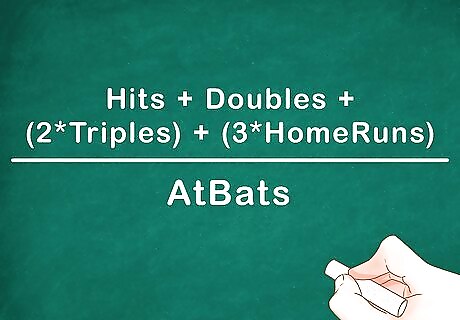
views
X
Research source
Nevertheless, for the average fan, batting average is a convenient and popular method for comparing offensive skill.
Calculating Batting Average

Find the player's hits. Hits (also called base hits) are simply the sum of singles, doubles, triples, and home runs. This statistic is easy to find online for professional players. You can use the statistics for a season, a whole career, or any other period of time you're interested in. Just make sure all your statistics come from the same time frame.

Find the player's at-bats. This is the number of times the player has made an attempt at an hit. This does not include walks, hits by pitch, or sacrifices, since these do not reflect the batter's offensive skill.

Divide the number of hits by the number of at-bats. The answer tells you the battering average, or the fraction of the time that a batter turned an at-bat attempt into a successful hit. For example, if a player had 70 Hits and 200 At-Bats, his Batting Average is 70 ÷ 200 = 0.350. You can read a batting average of 0.350 as "this player would expect to get 350 hits in 1000 at-bats."

Round to the third decimal place. Batting averages are almost always rounded this way. When a baseball fan mentions a batting average of "three hundred," she means 0.300. You can calculate batting averages to four or more decimal places, but this doesn't have much use beyond breaking ties. Mitchel Lichtman Mitchel Lichtman, Baseball Analyst To calculate batting average, take the number of base hits a player has and divide it by their number of at-bats. At-bats are defined as a plate appearance that results in the batter reaching base safely or being put out. Batting average is calculated to three decimal places and expressed as a percentage.
Calculating Other Offensive Stats

Find the on-base percentage. A player's OBP tells you the fraction of the time that player makes it to a base, including walks and hits by pitch. Some fans consider this a better metric than battering average, since it takes into account all scoring methods. To find OBP, calculate H i t s + W a l k s + H i t s B y P i t c h P l a t e A p p e a r a n c e s {\displaystyle {\frac {Hits+Walks+HitsByPitch}{PlateAppearances}}} {\frac {Hits+Walks+HitsByPitch}{PlateAppearances}}. This formula is good enough for most purposes, but it does count some uncommon plays that do not reflect on the batter's skill, such as sacrifice bunts and catcher's interferences. If you need to be precise, replace plate appearances with "at-bats + walks + hits by pitch + sacrifice flies."

Understand runs batted in. Runs batted in, or RBI, tell you how many times the team passed home plate due to this batter. For example, if there are two teammates on base and Sarah scores a home run, Sarah gets 3 RBI (two teammates + herself). This gives you a straightforward account of exactly how many runs a batter has scored. However, since it depends on other batters loading the bases, this statistic isn't a great way to compare players from different teams. Do not add to RBI if the at-bat led to a double play (two outs), or if a run only occurred due to an error.

Find slugging percentage. Slugging percentage is similar to a batting average, but counts the number of bases scored instead of just the number of hits. This rewards more powerful hitters who score more doubles, triples, and home runs. Slugging percentage equals H i t s + D o u b l e s + ( 2 ∗ T r i p l e s ) + ( 3 ∗ H o m e R u n s ) A t B a t s {\displaystyle {\frac {Hits+Doubles+(2*Triples)+(3*HomeRuns)}{AtBats}}} {\frac {Hits+Doubles+(2*Triples)+(3*HomeRuns)}{AtBats}}. You will get the same result if you count the bases in a more intuitive way: Singles + (2*Doubles) + (3*Triples) + (4*Home Runs). The formula above is usually easier to use since most baseball statistic websites do not list Singles.



















Comments
0 comment